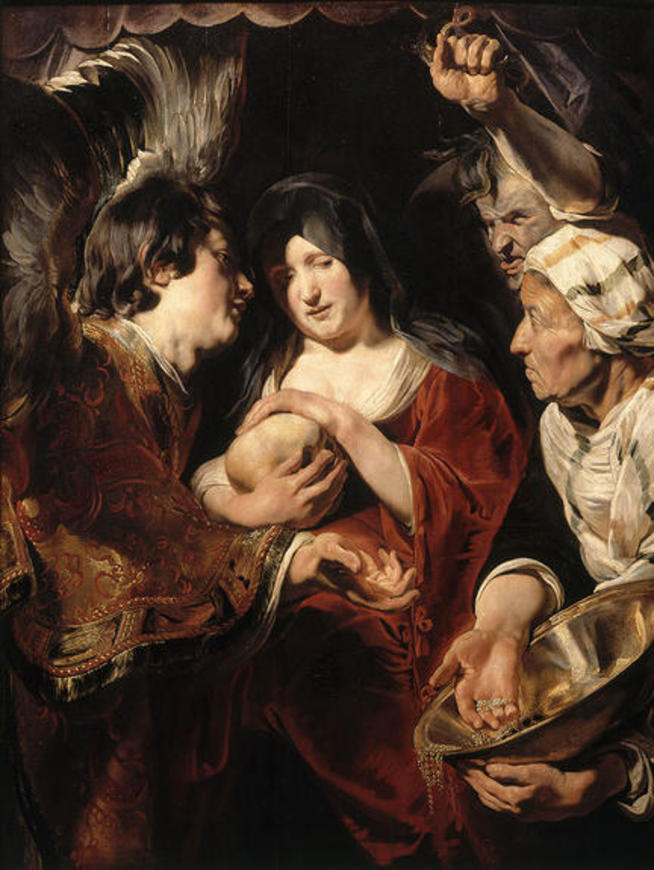What is this woman doing among all these strange characters? Her gaze seems to be drawn to the jewellery presented to her … What is she holding in her hands? And this angel, what is he trying to tell her?
Long interpreted as an allegory of youth between vice and virtue, the scene has a wholly different meaning. Here, an episode from the story of Mary Magdalene is represented. Created in the artist's youth, the "Temptation of Saint Magdalene" is a rare subject which Jordaens has interpreted several times.
Mary Magdalene was a former courtesan who renounced earthly pleasures to dedicate herself to a spiritual existence. After a life of debauchery, she took refuge in a cave to lead an ascetic life, far from vain riches …
But, alas, two figures have come to distract her: an old woman dangles jewellery, associated with lust, while a man sticks out his tongue. His grimace suggests gossip and envy, while the snakes he brandishes refer to the devil according to Christian symbolism. Luckily, an angel intervenes to lead the repentant sinner away from this evil encounter. The skull she preciously holds, a symbol of human vanity, must surely have helped her resist the temptation to adorn herself with these beautiful jewels once more!
Detail 1: In this moralising piece, the skull occupies a central position within the composition. An attribute of the hermit, it became a symbol of vanity in representations of Saint Mary Magdalene and other penitent saints, like Saint Francis.
Detail 2: In another painting within the museum, attributed to Abraham Janssens, Mary Magdalene is represented as a semi-naked courtesan. In a gesture of renouncement, she looks towards the sky: her existence, cluttered with riches, will be henceforth turned towards God. The skull, crucifix and Bible, instruments of meditation, contrast with the pile of jewellery, now belonging to the past.

What is this woman doing among all these strange characters? Her gaze seems to be drawn to the jewellery presented to her … What is she holding in her hands? And this angel, what is he trying to tell her?
Long interpreted as an allegory of youth between vice and virtue, the scene has a wholly different meaning. Here, an episode from the story of Mary Magdalene is represented. Created in the artist's youth, the "Temptation of Saint Magdalene" is a rare subject which Jordaens has interpreted several times.
Mary Magdalene was a former courtesan who renounced earthly pleasures to dedicate herself to a spiritual existence. After a life of debauchery, she took refuge in a cave to lead an ascetic life, far from vain riches …
But, alas, two figures have come to distract her: an old woman dangles jewellery, associated with lust, while a man sticks out his tongue. His grimace suggests gossip and envy, while the snakes he brandishes refer to the devil according to Christian symbolism. Luckily, an angel intervenes to lead the repentant sinner away from this evil encounter. The skull she preciously holds, a symbol of human vanity, must surely have helped her resist the temptation to adorn herself with these beautiful jewels once more!
Detail 1: In this moralising piece, the skull occupies a central position within the composition. An attribute of the hermit, it became a symbol of vanity in representations of Saint Mary Magdalene and other penitent saints, like Saint Francis.
Detail 2: In another painting within the museum, attributed to Abraham Janssens, Mary Magdalene is represented as a semi-naked courtesan. In a gesture of renouncement, she looks towards the sky: her existence, cluttered with riches, will be henceforth turned towards God. The skull, crucifix and Bible, instruments of meditation, contrast with the pile of jewellery, now belonging to the past.